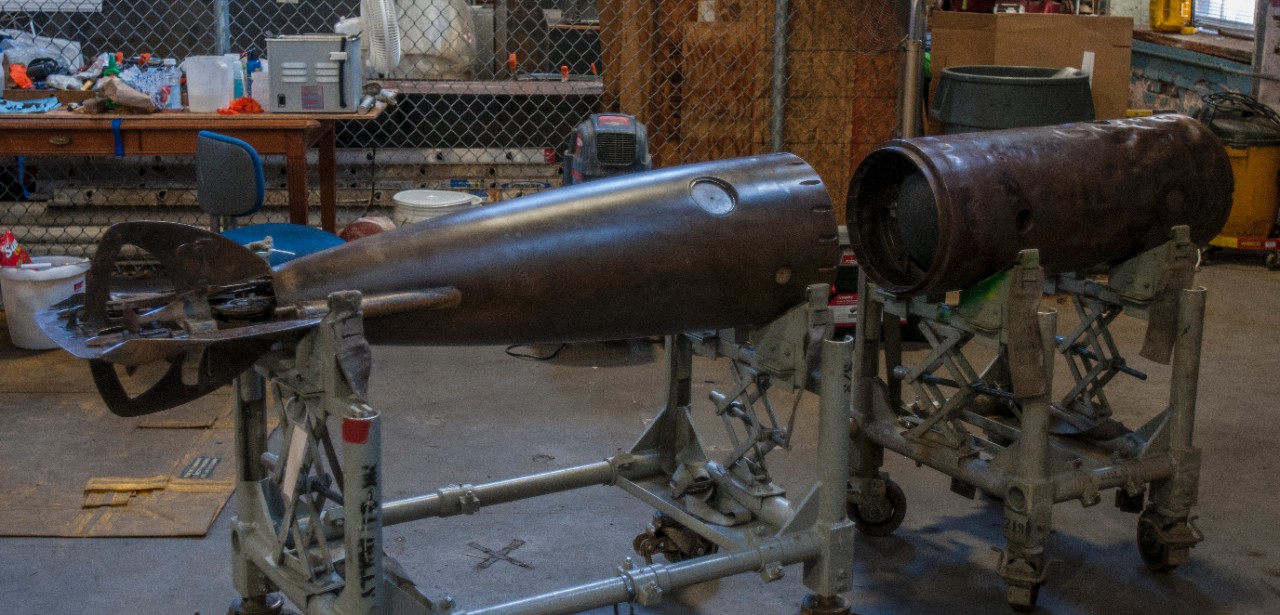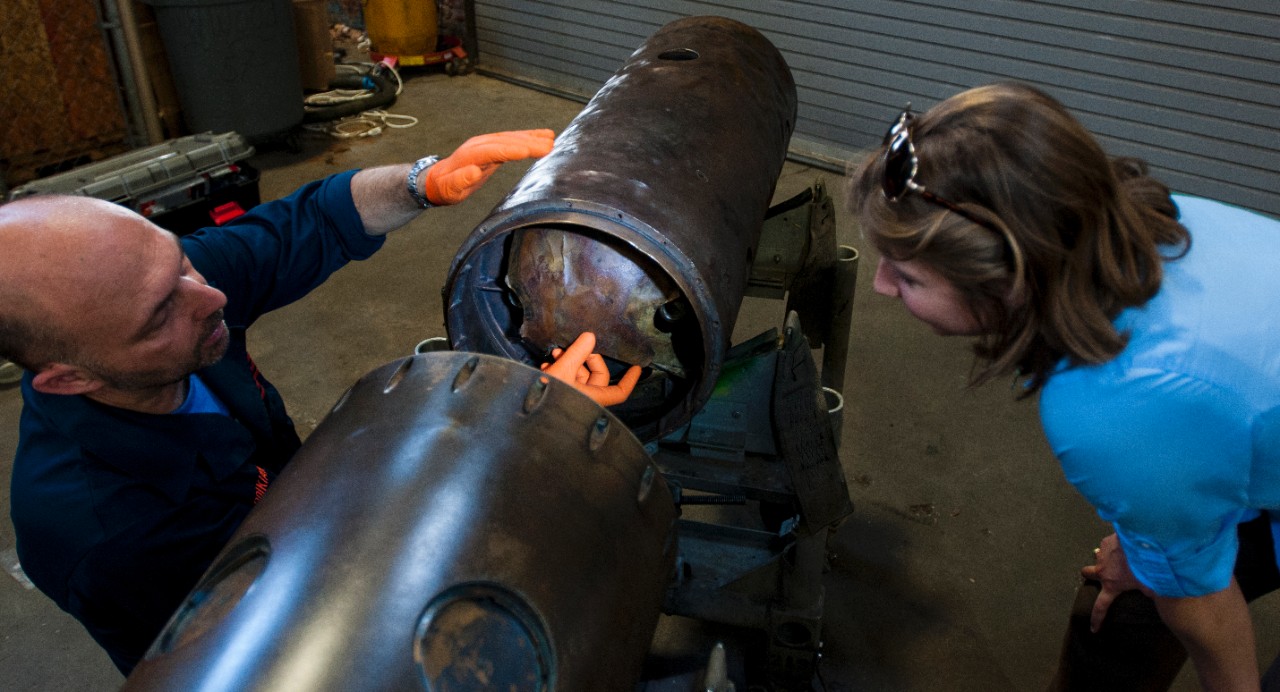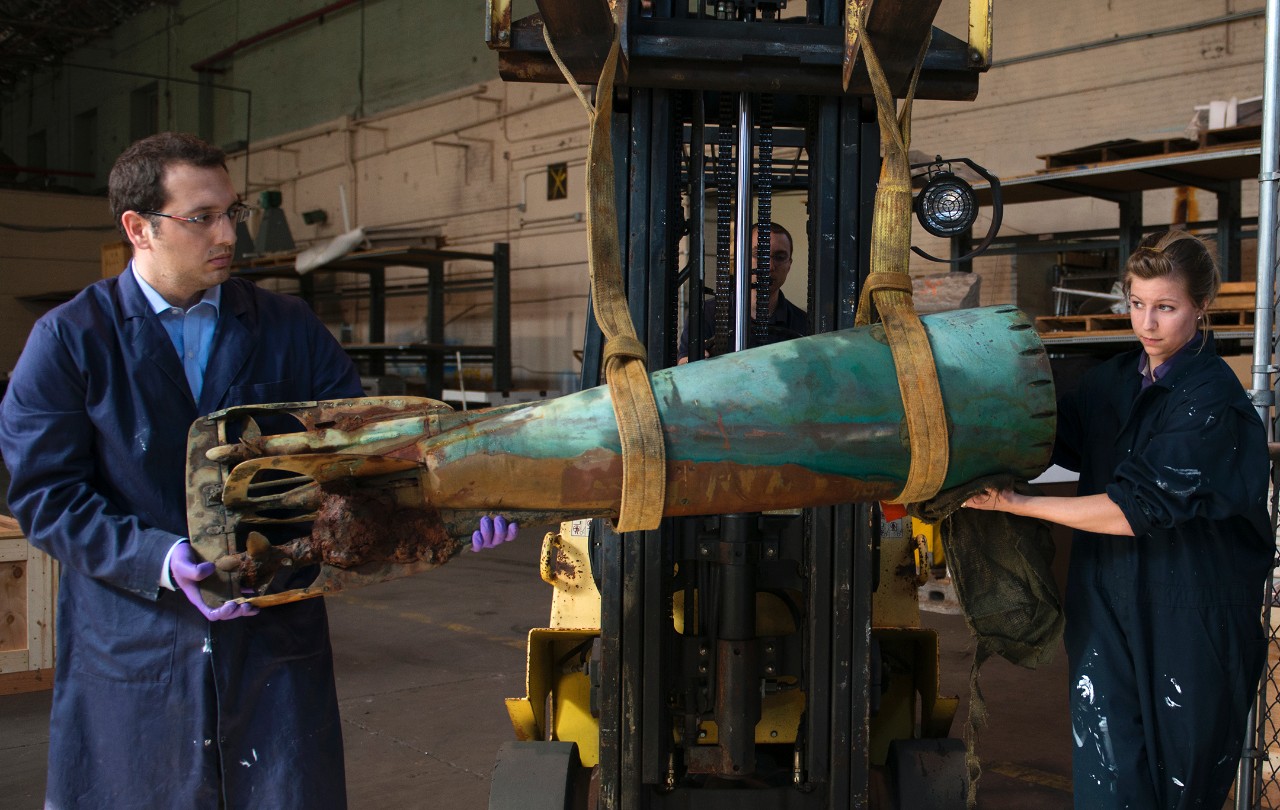By Sandy Gall, Naval History and Heritage Command, Communication and Outreach Division
WASHINGTON, D.C. -- The best things in life are worth waiting for and, especially in the conservation of archaeological material, the best treatments must often be deliberately slow and gradual to ensure immediate and long-term preservation of artifacts. That notion holds true when speaking to the Naval History and Heritage Command's (NHHC) Underwater Archaeology (UA) Branch about Howell Mark I Torpedo No. 24. The middle- and after-body sections of No. 24 were discovered in March 2013 off the coast of San Diego by a team of U.S. Navy dolphins. Following recovery, the torpedo was flown to Washington, DC in custom-built crates and transported to the UA Archaeology & Conservation Laboratory on the Washington Navy Yard. After more than two years since its arrival at NHHC, and nearly 18 months of treatment, conservation of No. 24 is complete and the final result is stunning.

NHHC archaeological conservators worked with Paul Mardikian and Claudia Chemello, senior conservators with Terra Mare Conservation, LLC, contracted through SEARCH, Inc., for nearly 18 months to desalinate, clean and stabilize every part of No. 24. The team encountered and overcame multiple challenges throughout the treatment, most of which stemmed from limited access to all parts of the object. The middle-body section, for example, was recovered sealed at both ends and when conservators opened the forward bulkhead they were surprised to see the interior cavity nearly filled with sediment. In order to access all parts of the middle-body interior, conservators systematically removed more than 130 lbs. (60 kg) of compacted sediment, carefully excavated in 5 cm slices, which were then screened by the UA team to ensure that any parts originating from the torpedo were saved for treatment.
Archaeologists offer valuable insight into aspects of archaeological material which can significantly inform the treatment process. Artifacts in turn can help answer specific research questions about a particular ship or aircraft wreck and often important discoveries about archaeological sites are made in the conservation laboratory. The collaboration between archaeologists and conservators was an important feature of the Howell torpedo project, “and a great example of how we work well together to achieve best practices in the stewardship of archaeological resources,” says Claudia Chemello.

For Paul Mardikian, one of the greatest accomplishments of the treatment has been the successful stabilization of what he calls “the heart of the torpedo”- the 130-lb forged steel fly-wheel located in the aft of the middle-body section. Originally, conservators had hoped to remove and clean the fly-wheel separately, however physical distortion of the middle-body prevented its removal and the team was faced with the challenging task of treating it in situ. Conservators used small pneumatic chisels and custom-made hand tools to mechanically break the thick, compacted iron concretion around the fly-wheel, eventually freeing it.
“Because of all the thick iron concretion that had built up around [the fly-wheel], we knew it would be extremely difficult,” said Mardikian. “But in the end it’s extremely rewarding to see this object perfectly preserved and to see the fly-wheel turn again!”
In addition to mechanical cleaning methods, conservators also employed specially-selected chemical solutions to perform specific functions during the treatment. Both the middle- and after-body sections of No. 24 were fully submerged in sequential chemical baths designed to help stabilize, clean and desalinate the artifact. Localized electrolysis was also applied to the fly-wheel to protect it during the treatment process while encouraging chloride (salt) extraction. For archaeological metal artifacts, especially those recovered from a marine environment, chloride removal is the first and most important step of treatment. Consequently, desalination is often the longest part of treatment because residual chloride compounds can cause numerous problems including corrosion of metal and physical destruction of the object.
As one of only 50 Howell Mark I torpedoes produced, conservators were acutely aware of No. 24’s special place in history throughout the treatment. “It’s the granddaddy of all the Navy’s torpedoes,” Mardikian remarked.
No. 24 is a truly amazing artifact and offers a rare, tangible glimpse into the Navy’s early weapons development. From nose to tail, the Howell Mark I measured 11 feet (3.3 m) long and just over 14 inches (36 cm) in diameter. Fully armed with 100 lbs. (45 kg) of explosive material in the nose cone, it weighed 580 lbs. (263 kg) total. Prior to launch, the torpedo’s fly-wheel was spun up to 10,000 rpm by an on-deck steam turbine and once deployed, the weapon could reach a maximum speed of 25 knots (46 kph) over a 400 yard (365 m) range. Use of the fly-wheel streamlined the torpedo’s design and gave it multiple advantages over other more complex, compressed air torpedoes produced in the late 19th century.
Kate Morrand, Senior Conservator at UA’s Archaeology & Conservation Laboratory, recounts the teamwork and collaboration within NHHC and Navy throughout the project. “Navy’s archival records can be one of our most valuable tools to help understand specific characteristics of the artifacts and for this project have been indispensable. We were able to refer to the original Howell Mark I Torpedo manual printed in 1890 from the NHHC Library collection which contained detailed drawings and descriptions of each part of the object,” Morrand said. “Through Navy records and ship logs, we were also able to find out exactly what happened to No. 24 and the circumstances of its loss.”
No. 24 is now one of three existing Howell torpedoes, the other two in existence, No. 18 and No. 35, are at the NHHC Naval War College Museum and the NHHC Naval Undersea Museum respectively. “No. 18 and No. 35 are more intact than No. 24,” Morrand continued, “so we reached out to the curation teams at those museums multiple times throughout the treatment process, and they were extremely helpful and provided data for us to do comparative studies.”
Now that conservation treatment is complete, No. 24 is awaiting the next step in its nearly 125-year history. “We’re working to place it on display for the public to see,” says Morrand. “We’re hoping to contribute the research we’ve done to help develop a really engaging exhibit for people to learn about this unique artifact and a very important time in our country’s history.”
Find out more about the Howell Mark I Torpedo No. 24’s journey – check out the links below for a chronicle of the Howell’s discovery, recovery and conservation.

Howell Mark I Torpedo No. 24 Timeline:
MAR 2013 – Trained dolphins, part of Navy’s Marine Mammal Program of the Space and Navy Warfare Systems Center Pacific (SPAWAR), discover No. 24 off the coast of San Diego. SPAWAR works with the Naval History & Heritage Command (NHHC) to identify the torpedo model, certify it safely inert, and coordinate its transportation to NHHC headquarters.
MAY 2013 – No. 24 arrives to NHHC headquarters on the Washington Navy Yard, DC for stabilization and conservation treatment at the UA Archaeology & Conservation Laboratory. Both the middle- and after-body sections are submerged in water to initiate desalination.
JUN - JUL 2013 – NHHC UA conservators begin documentation, research and stabilization of the middle- and after-body sections of No. 24.
AUG 2013 – NHHC UA Branch research confirms loss of No. 24 from USS Iowa through consultation of Navy archival records and ship logs.
- OCT— DEC 2013 – NHHC UA conservators initiate work with Terra Mare Conservation, LLC through SEARCH Inc., to begin active conservation treatment of No. 24 at the Archaeology & Conservation Laboratory on the Washington Navy Yard. Both the middle- and after-body sections are moved into specially-selected chemical baths to encourage desalination and cleaning.
JAN 2014 – NHHC UA and Terra Mare conservators and UA archaeologists open, excavate and screen No. 24’s middle-body section. Conservators work to partially disassemble No. 24 where possible and allow for more comprehensive treatment of smaller components.
MAR – APR 2014 – Conservators focus on mechanical cleaning and removal of concretion from the middle- and after-body sections of No. 24 while continually monitoring desalination progress.
MAY 2014 – NHHC archaeological conservators and engineers from Naval Surface Warfare Center, Philadelphia (NSWC) collaborate to begin the first of three laser scanning sessions for a 3-D documentation project of No. 24. Conservators determine fly-wheel must be left in situ for treatment.
JUL 2014 – No. 24’s middle-body section begins localized electrolysis on the fly-wheel. Engineers from NSWC Philadelphia complete second 3-D laser scan of No. 24.
SEP – DEC 2014 – Conservators focus on mechanical cleaning and concretion removal around the fly-wheel in the middle-body section and the after-body section gears and propellers while continually monitoring desalination progress.
FEB – APR 2015 – Conservators focus on mechanical cleaning and concretion removal around the fly-wheel in the middle-body section and treatment of smaller disassembled components while continually monitoring desalination progress.
MAY 2015 – After-body section finishes desalination and cleaning. Conservators complete treatment and reassemble the after-body’s mechanical and structural components.
JUN – JUL 2015 – Middle-body section finishes desalination and cleaning. Conservators complete treatment and reassemble structural components.
NOV 2015 – Engineers from Naval Surface Warfare Center Philadelphia return to do a final comprehensive 3-D laser scan of No. 24.


